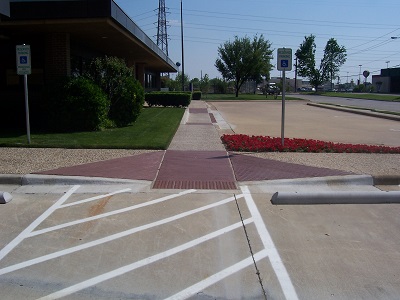Visual Scanning with Low Vision
Living with vision loss can make everyday activities—from walking across a parking lot to finding an item on a shelf—more challenging and potentially less safe. Obstacles, drop-offs, glare, and reduced contrast sensitivity can all interfere with mobility and increase the risk of falls. Fortunately, using organized scanning techniques can help individuals with visual impairments make the most of their remaining vision, identify hazards early, and move through environments more confidently. This article explains common scanning patterns, how to apply them in daily situations, and ways to build efficiency through practice.

Horizontal Pattern
The first pattern is a horizontal pattern. You may have used this pattern when you completed a word search puzzle.
- With this pattern, start at the upper left area you want to scan.
- Your head, eyes, or both should move from left to right across the area.
- Once you reach the far right side, drop your gaze down slightly and move back to the left.
- Then, drop down and move to the right across the space.
- Continue to repeat this systematic pattern until the entire space is covered.
- You can practice this technique by placing rows of cards on a table or by doing a large print word search.
For larger areas, such as walking, you need to first set boundaries to the sides of where you need to scan.
- For example, do you need to just scan the space in front of your body, or do you need to look from wall to wall in the hallway?
- Maybe you are looking for something in a cupboard or on a grocery store shelf where the boundaries may be the edge of the cupboard or an arm’s length in all directions.
- You might also use this pattern to search up high for a sign in the grocery store.
Vertical Pattern
The second pattern is a vertical pattern. It is very similar to the horizontal pattern, but instead of moving your head or eyes from left to right, you are looking up and down.
- Start again in the upper left corner of the area.
- Scan down as if you are following an imaginary column.
- Move your gaze slightly to the right, and scan back up the column.
- This pattern might be used when sweeping the floor, mowing the lawn, vacuuming, playing putt-putt golf or locating the correct button in the elevator.
Scanning and Walking
When walking, you can use a combination of both patterns. You should try to scan approximately four or five steps ahead of your feet so that you have enough time to react if you spot an obstacle.
- First, scan from left to right approximately four to five steps ahead, then quickly scan vertically back toward your feet.
- Next, look up and scan for people or signs at eye level.
- Drop your gaze to the ground, scan from left to right again, then quickly scan vertically back toward your feet.
- You can use combination techniques at crosswalks to horizontally scan for cars and vertically scan the path of travel.
- When looking for a pedestrian signal (walk/don’t walk sign), you can scan horizontally along the curb to locate the pole, then scan vertically up to locate the signal.
Systematic Scanning Requires Practice
It may seem that systematic scanning is time-consuming, but it is much more effective to locate hazards or needed items. It allows the entire area to be covered quickly in an organized manner.
An individual with vision loss needs repeated practice to master using these patterns. Start slowly in familiar environments. At first, it may be easier to stand still to scan, and add movement or walking once you feel more comfortable with the patterns. Eventually, the patterns become automatic and will keep you safe in all types of environments.
Useful Environmental Cues

Scanning your environment is easier if there are some built-in environmental cues. For example:
- Paint crosswalks in parking lots, streets and driveways.
- Paint curbs and slanted areas yellow.
- Avoid placing obstacles in usual pedestrian pathways or blocking sidewalks with snow shoveled from road.
- Add yellow paint to railings and bases of freestanding objects and protrusions, such as signs, trash receptacles and planter boxes.
Learning to scan systematically is a powerful way to increase safety, independence, and confidence in daily life. By practicing horizontal and vertical scanning patterns, and combining them when walking or navigating busy environments, you can cover your surroundings more thoroughly and reduce the likelihood of missing important details. Over time, these techniques become second nature, allowing you to respond quickly to hazards, locate what you need, and travel with greater ease. Remember: effective scanning takes practice, but the reward is the ability to engage more fully and independently in your everyday activities.
By Anne Riddering, OTR/L, CLVT, COMS